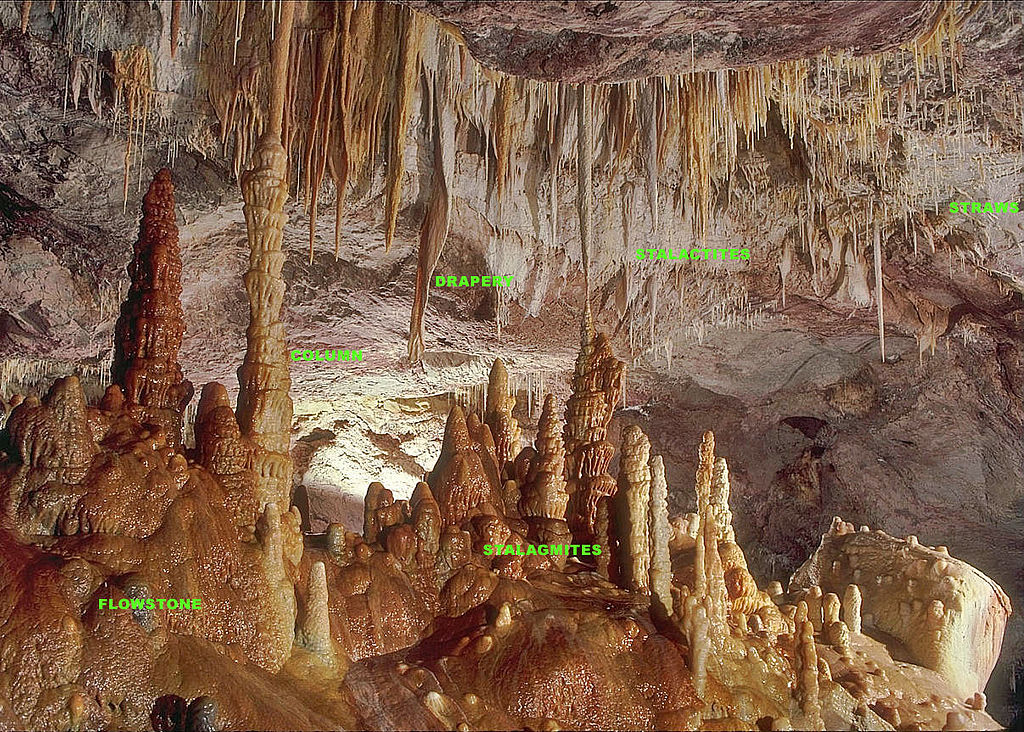I have earned GSA's highest level:

You can track our Platinum Earthcache Master Geocoin here:

The Cave Of Wisdom Of God
On the Western fringes of the White Mountains in the Topolia Gorge, at an altitude of 400 m. is the Cave of Wisdom Of God. A cave linked to legends, traditions and history.
The cave was explored be speleologist Anna Petrohilou and found it very interesting. The dimensions of the cave are recorded to be 100 m. wide and about 100 m. deep. The Wet cave contains five rows of massive stalactites and stalagmites that make it seem like magic. A unique species named “Jhermofora Poholia” was first discovered here.
Between two huge stalagmites, located opposite of the entrance of the cave, one will notice the mark of a horseshoe. Tradition says that it is the mark left from the horse of Saint Demetrius, which was made by its huge leap from the church of saint Demetrius which is on the opposite side of the valley.
In the depth of the cave, you can observe fallen rocks that has covered an opening which is said to link you to the other side of the mountain. A myth related to this says that a ram was let through this opening with candles stuck on its horns, and was later found in the village of Sirikari on the other side of the mountain.
In West Crete, metamorphic rocks stretch from the limestone of the west coast, ending dramatically in two mountains of gypsum. They often form a shallow, clayey, water-retaining soil, covered with maquis or low woodland of arbutus and tree-heather. Some conglomerates and breccias behave as hard limestone. A ridge of Miocene Conglomerate contains an amazing series of gorges and hills behind Kastelli Kissámou. Among this the Topolia Gorge. However, breaches in the tufa crust allow pebbles to drop out from within, creating sharp-edged caverns.
Karstification
The Formation af the cave can be explained by the process of karstification. Normal rainwater is slightly acid and when it trickles the limestone it dissolves it. Any crack or depression, once started, collects water and tends to enlarge. On the surface this produces over millennia, a funnel-shaped sinkhole. Underground fissures enlarge into systems of channels and caverns on many levels. These underground roadways direct the flow of groundwater. The ceilings of some of these caverns gradually get thinner until they collapse, adding to the solution sinkholes which are common in the Cretan landscape. A sinkhole can appear by this process overnight.

Jobelaja kids at the big stalagmite.
Limestone stalactites and stalagmites
The most common stalactites are speleothem which occur in limestone caves. They form through deposition of calcium carbonate and other minerals, which is precipitated from mineralized water solutions. Limestone is the chief form of calcium carbonate rock which is dissolved by water that contains carbon dioxide, forming a calcium bicarbonate solution in underground caverns.The chemical formula for this reaction is: CaCO3 + H2O) + CO2 → Ca(HCO3)2
This solution travels through the rock until it reaches an edge and if this is on the roof of a cave it will drip down. When the solution comes into contact with air the chemical reaction that created it is reversed and particles of calcium carbonate are deposited. The reversed reaction is: Ca(HCO3) 2 → CaCO3 + H2O + CO2

The 6 most common types of speleothems
An average growth rate is 0.13 mm (0.0051 inches) a year. The quickest growing stalactites are those formed by a constant supply of slow dripping water rich in calcium carbonate (CaCO3) and carbon dioxide (CO2), which can grow at 3 mm (0.12 inches) per year. The drip rate must be slow enough to allow the CO2 to degas from the solution into the cave atmosphere, resulting in deposition of CaCO3 on the stalactite. Too fast a drip rate and the solution, still carrying most of the CaCO3, falls to the cave floor where degassing occurs and CaCO3 is deposited as a stalagmite.
All limestone stalactites begin with a single mineral-laden drop of water. When the drop falls, it deposits the thinnest ring of calcite. Each subsequent drop that forms and falls deposits another calcite ring. Eventually, these rings form a very narrow (≈4 to 5 mm diameter), hollow tube commonly known as a "soda straw" stalactite. Soda straws can grow quite long, but are very fragile. If they become plugged by debris, water begins flowing over the outside, depositing more calcite and creating the more familiar cone-shaped stalactite. The same water drops that fall from the tip of a stalactite deposit more calcite on the floor below, eventually resulting in a rounded or cone-shaped stalagmite. Unlike stalactites, stalagmites never start out as hollow "soda straws." Given enough time, these formations can meet and fuse to create pillars of calcium carbonate known as a "column".
Source: The Making of the Cretan landscape, Rackham/Moody.
To log the cache please answer the following questions, and send the answers to our profile.
1: Go to the back of the cave. Here you´ll notice a classic stalactite/stalagmite formation. Estimate how many years it´ll take for the speleothem process to fill the gap and form a column.
2: How many of the six most common types of speleothems can you see in the cave?
3: Estimate the height, diameter and age of the large stalagmite in the middle of the cave. (See photo)
4: (Optional) Take a photo of you and your GPSr in the cave and upload it to your log.
Do not hesitate to log the cache. I will contact you if there are any problems.
First to find credability goes to Mkivimaki of Finland as they were the first team to send in answers to the questions.
